Great Photographs No. 1
Boulevard du Temple, Paris, 8 in the morning
Louis-Jacques-Mandé Daguerre
This astonishing image has to rank amongst the 100 greatest photographs of all time …
It is a daguerrotype, taken by Louis-Jacques-Mandé Daguerre (after whom the process was named), an image recorded on a sheet of copper coated with silver and developed by mercury fumes. Ironically the hour at which it was taken is known, but the year is not. It was either 1838 or 1839.
At first glance this may seem like a rather ordinary … even boring … subject. And it’s badly scratched too. Aren’t I saying its so great, simply because its so old?
No.
Look carefully to the bottom left. (You can click on the image to see it full-size.) There you will see two human figures, a customer having his shoes polished by a bootblack. These two unknown characters were the first humans to be photographed. Their simple, everyday transaction has made them immortal.
How come there is no one else in the image? Weren’t the streets of Paris busy at that time?
They were. But Daguerre would have had to use an exposure of 10-15 minutes to get this image. So all the other Parisians, bustling back and forth, have not have been recorded. Such was the length of exposure that anything in the frame for less that a few minutes would not register.
All the commentaries on this photograph that I have read speculate that these two were probably unaware that they were being recorded. And they say that Daguerre knew neither of them. One photo-historian writes, “He (Daguerre) quite possibly didn’t notice them as he focused his camera, but his plate remained true to nature, and one can imagine his delight when the mercury fumes revealed their presence during development.”
I wonder if that could be true.
Daguerre would have known that people moving about would not record on his plate and I have a sneaking suspicion he planted these two. Apart from anything else, who has one shoe polished for 10 to 15 minutes? Then it’s a slightly odd place for a bootblack to set up business, right on a corner, close to the kerb, and directly in the path of people walking up and down the road.
Finally, these two are very conveniently placed close to the classic compositional ‘thirds’ position.
I think that it has been set up … not that this detracts from the image in any way. Those two make the picture. I’m guessing that Daguerre knew a thing or two about composition as well as developing plates with mercury fumes. He knew that a ‘heartbeat’ would improve his image. But he couldn’t just have a person or two standing motionless on the street corner. Apart from the fact that it would look odd to passers-by, it would also look odd on the image. So, get them to do something, and what more natural than a shoe shine?
In a further bizarre twist of fate, we can still see and appreciate this image because of an invention of Daguerre’s great rival, William Henry Fox Talbot. Fox Talbot invented the calotype which was the precursor of modern film photography. (Film photography replaced the daguerrotype process and made it obsolete.)
Whilst this daguerrotype was display in a museum in Munich, in 1937, an eminent photo-historian, Beaumont Newhall commissioned a very high-quality photograph of it … using photographic film of course (i.e. based on Fox Talbot’s invention).
Subsequently, Daguerre’s picture survived the bombings of Munich in 1940 but, shortly after the war, an over-zealous museum curator attempted to clean it. The mercury amalgamated to the silver was incredibly fragile – likened to the powdery scales on a butterfly’s wings – and the hapless curator wiped the whole thing clean.
But Beaumont Newhall’s photograph of it survived. And a replica daguerrotype could be made.
An amazing story around a truly great photograph.
Return to Great Photographs page
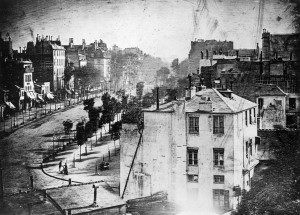

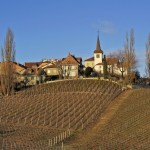
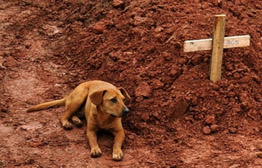
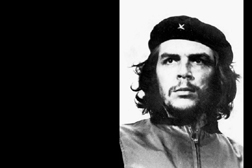
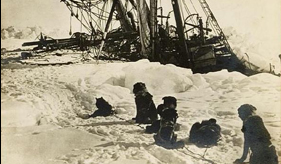
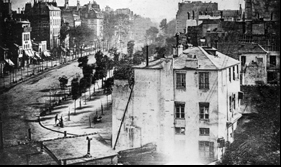
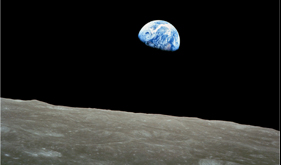
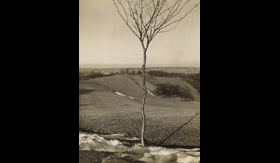
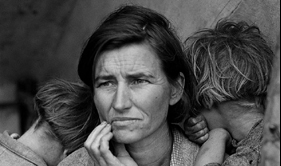
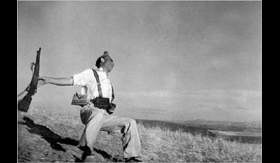
Is there any way to find out what the current name of the intersection in Paris is for this photograph? I see Rue du Temple but do we know what the cross street might be?
Au Contraire, mon frere Alistaire – on your exposure time of 15 min. Surely the man having his shoes polished would not have stood stock-still that long, nor his polisher been so clearly rendered. Wouldn’t his left leg have moved enough in 15 minutes to render more blur ? I think so. My guess is the exposure is be less than two minutes. Also, if you look closely in the background and the shadows, other figures are revealed. The date most often given for the piece is 1838. Newhall’s book shows two views taken the same day, which is instructive.
How can I obtain copies of the photograph (boulevard du temple 1838 daguerre)?
Thanks for your question, Marie. But I’m sorry to say I can’t answer it. I have no idea how to obtain copies of the photo. Maybe contact the museum where it is on display.
Couldn’t she simply find it on line and print it?
Yeah … of course. Thanks Dave. In fact, she could probably print off the image I’ve posted. It’s pretty big. Right-click on it, save it somewhere convenient, and print from that. It’s not in copyright any longer.
Bonjour Messieurs,
je pense que le premier personnage représenté sur une photographie est celui effectué par Daguerre avec son objectif de 6 pouces de foyer au Pont-Neuf. C’est le premier objectif mis au point par Daguerre, utilisable avec le physiotype.
Il est certain que ce dernier utilisait ses objectifs à différentes ouvertures comme il le mentionne dans les différentes correspondances avec Niépce.(voir par exemple ma page sur le point de vue du Gras)
Je propose dans mon étude sur le boulevard du Temple, que ces essais ont pu être effectué à une autre ouverture. A F/14 le temps nécessaire est de 10 à 15 minutes, à F/9 comme je le propose, le temps est plus vraisemblable pour la fixation du mouvement du personnage.
En attendant vos avis, mes sincères salutations.
Roquencourt
Hi; I enjoyed your views on this classic photo. There is some speculation that there is in fact a third person present – a little child peering from the top left window of the white building in the foreground. Personally I think it’s a plant pot! But still worth thinking about. Here’s a chap who has really analysed the picture! http://www.niepce-daguerre.com/boulevard_du_Temple_de_dag.html
Thanks for that observation. Yes, I have been in discussion with someone else over the possibility of a child peering out of that window. Like you, don’t think it is another human being, particularly not a child. The child would have had to have been peering, motionless, out of that window for 10-15 minutes in order to appear. What child would do that?
Definitely a child, not a vase. The curtain is pulled aside and the window is closed (so not wind that blew the curtain open+it would not have stay like that for 10 minute exposure) so it would have to have been pulled aside by the child to stand there and look through the window. If it were a vase the curtain would not be pulled aside. My take on it.
I don’t think the figures in the corner were planted. The shoe black positioned himself near the beginning of a stretch of pavement where customers would be tempted to get their shoes cleaned and polished after walking in the dirt. Notice that on the other side of the street there is no pavement.
Thanks for your comment Kim. I agree with you that it is an ideal position for a shoe-shiner to work. Maybe, on reflection, my use of the word ‘planted’ is not quite right. But I can’t help wondering if these two weren’t somehow working with Daguerre. What puzzles me is what I wrote – the exposure for this image was a very long one (which is why there are no other figures showing). If the two who do appear had moved at all, their image would be blurred or even non-existent.
I guess we’ll never know, which is another great aspect of this photo. It gives room for speculation.
It’s not true that “if the two had moved at all, their image would be blurred or non-existent”. Although the exposure was around 10-15 minutes, their image would have shown up as long as they were in the same position for a good proportion of that time – not necessarily all of it. If you stand in one place for a long period of time, your image is recorded. If you then quickly move away, you won’t blur that image. All that will happen is that some of the background will now start to bleed through your stationary image, until the exposure ends.
Thanks for your comment, Bob. Yes, you are correct. I guess I was a bit over the top saying, “… if they had moved at all.” It’s a sort of sliding scale. With long exposures such as this, the longer something is in one place, the more ‘solid’ it becomes. Once, when I’d broken my leg skiing and, through lack of mobility, was feeling a bit detached from the world, I experimented with long exposure pinhole photography. This is a 30 second self-portrait, and I stayed in the image for 15 of those seconds before hobbling away. The intention was to achieve a sort of ‘ephemeral’ effect.
Even so, Daguerre’s figures are so solid it makes me suspect that they’ve been deliberately placed (not that there’s anything wrong with that).
“But Beaumont Newhall’s photograph of it survived. And a replica daguerrotype could be made.”
So what we’re looking at is a compressed JPEG of a scanned image of a photograph of a daguerrotype of a photograph of a daguerrotype? I guess we can forgive its limited pixel-peeping potential then!
Wow! Thanks David. I never thought of it that way.
Thank you for the comment. Unfortunately I don’t read or speak Spanish. But for those who do …